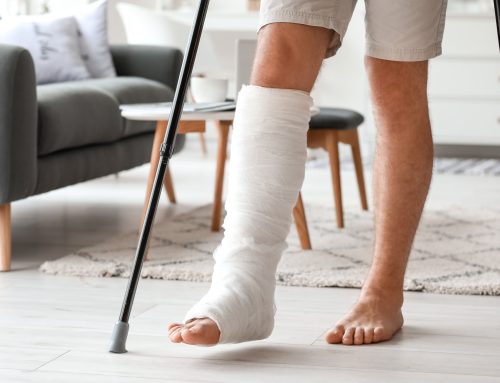Aside from it being painful, a broken ankle can be extremely inconvenient. Suddenly, you’re no longer able to complete day-to-day activities with ease. Depending on the severity of the break, it can take 6-8+ weeks to heal. After your initial visit to the doctor to have your bones set in place, you’ll be limited on what kind of ankle exercises you can do, especially if you require a cast for immobilization.

However, there are some ankle exercises you can incorporate at different stages of the healing process to get you back to pre-injury living faster. Read on to learn more about the best exercises for a broken ankle to improve your strength and flexibility.
Ankle Exercises for Rehabilitation
Your ankle is a strong support system for your body. Focusing on its flexibility, balance, and strength during your regular exercise routine can help you prevent an accidental injury. This joint is where the talus bone, tibia, and fibula connect - a break in any of these bones can cause pain and significantly reduce mobility. Before doing any ankle exercises, you need to see a doctor if you suspect you have a broken ankle.
If you don’t get the proper medical attention, you could have a permanent mobility reduction or deformity due to the bones not setting correctly within a reasonable time. From there, you should follow up with your doctor for regular check-ups and get their go-ahead before attempting any exercises that may cause more harm than good at that stage of your healing process.
There are three categories you should be focusing on to get your broken ankle back to pre-injury living. This includes:
- Flexibility
- Strength
- Balance
Before rushing into any exercises, give your broken ankle a warm-up since it’ll be stiff from immobilization. This can be as simple as pointing your toes and flexing your feet or bending your ankle, if able.
Flexibility for your broken ankle.
Flexibility is crucial for the health of your muscles, joints, and circulation. Calf stretches are great options that can be done in the early stages of healing by applying the right amount of pressure in the correct position.
You can do this at home with a towel and sit on the floor with either your knee straight or bent. If you choose to bend your knee, you’ll need to put a pillow or foam roller under the knee of your affected leg.
From there, you can put the towel around your foot, holding each end of the towel. Pull back gently to apply pressure and hold for 15-30 seconds. You can repeat this 2-4 times up to 5 times per day.
Strengthening your broken ankle.
You'll eventually need to add strengthening exercises to get back to your usual walking pace. This will also help you avoid another fracture since your broken ankle will be weaker than it was pre-injury. Your doctor will be able to give you a set of ankle exercises for strength that are appropriate based on your injury’s stage.
A resistance band is great for a number of strength-based ankle exercises, such as:
- Resisted ankle plantar flexion: Sitting on the ground with your affected ankle straight, place the resistance band around your foot. You’ll then gently flex your foot down and up 8-12 times while pulling back on the band for added resistance.
- Resisted ankle dorsiflexion: Loop the resistance band around a table leg or other secure object while sitting opposite it on the floor. You’ll loop the other end over the top of your foot and slowly flex your foot to pull back 8-12 times.
As you progress, you can also incorporate heel raises. At the final stage of your healing, your doctor may recommend plyometric exercises (aka, jumping and hopping) to help your ankle get used to high-impact activities such as running or playing sports.
Ankle exercises for improving balance.
You’re more likely to suffer from a broken ankle if you lose your balance. Including balance-focused exercises will help round out your routine. As you progress, your doctor may recommend balancing on one leg. Over time, you can continue this progression on a BOSU or wobble board.
Broken Ankle Exercise Tips
Before starting any rehabilitation journey, you should wait for your doctor's clearance. While some exercises are recommended, you also need to listen to your body. These are the top things to keep in mind when considering ankle exercises:
- Get your doctor’s advice on appropriate exercises for your broken ankle stage.
- Always do a warm-up before diving in.
- Don’t push yourself to the point of pain. Listen to your body and modify the exercises as needed.
A broken ankle can be a massive inconvenience beyond experiencing pain and discomfort. Even when you no longer rely on a cast, you may have difficulty returning to your regular activities. There is a way to get back to pre-injury living faster without waiting until you’re ready for ankle exercises. Low-Intensity Pulsed Ultrasound Therapy heals fresh fractures 38% more quickly than the traditional timeline. You can do this method for 20 minutes a day while catching up on your favourite TV show without supervision. Get in touch with us to get the device that helps Canadians heal faster for a better quality of life.
Have you ever broken your ankle? How long did it take to heal? What was the worst part of the experience? Share your story with our readers in the comments below.





